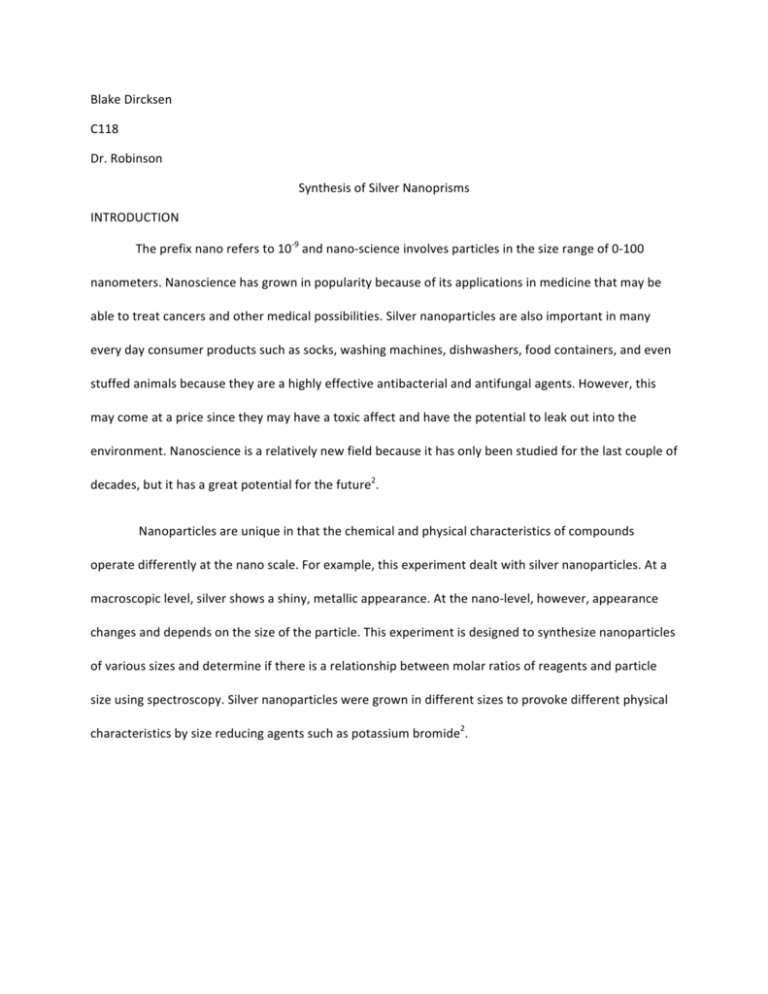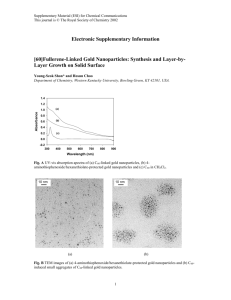Blake Dircksen C118 Dr. Robinson Synthesis of Silver Nanoprisms
advertisement

Blake Dircksen C118 Dr. Robinson Synthesis of Silver Nanoprisms INTRODUCTION The prefix nano refers to 10-­‐9 and nano-­‐science involves particles in the size range of 0-­‐100 nanometers. Nanoscience has grown in popularity because of its applications in medicine that may be able to treat cancers and other medical possibilities. Silver nanoparticles are also important in many every day consumer products such as socks, washing machines, dishwashers, food containers, and even stuffed animals because they are a highly effective antibacterial and antifungal agents. However, this may come at a price since they may have a toxic affect and have the potential to leak out into the environment. Nanoscience is a relatively new field because it has only been studied for the last couple of decades, but it has a great potential for the future2. Nanoparticles are unique in that the chemical and physical characteristics of compounds operate differently at the nano scale. For example, this experiment dealt with silver nanoparticles. At a macroscopic level, silver shows a shiny, metallic appearance. At the nano-­‐level, however, appearance changes and depends on the size of the particle. This experiment is designed to synthesize nanoparticles of various sizes and determine if there is a relationship between molar ratios of reagents and particle size using spectroscopy. Silver nanoparticles were grown in different sizes to provoke different physical characteristics by size reducing agents such as potassium bromide2. METHODS Silver nanoparticles of various nanoscale sizes were constructed and their chemical and physical properties were observed. Four vials labeled #1-­‐#4 were set out for four different trials. Different concentrations of sodium borohydride and hydrogen peroxide were used to establish an equilibrium between oxidation and reduction of silver. An amount of 2.5 mL of 1.0 x 10-­‐3 M sodium borohydride was added to each vial to reduce the silver ions into silver atoms, and 5.0 mL of 0.05 M hydrogen peroxide was added to each vial as an etching agent2,3. An illustration of how 0.05 M hydrogen peroxide was prepared from 9.79 M hydrogen peroxide is shown in equation 1 below: M1V1 = M2V2 Eq. 1 (9.79M)(V1) = (0.05M)(100mL) V1 = 0.51 mL of 9.79 M H2O2 in 100 mL of Millipore H2O An amount of 2.0 mL of sodium citrate dihydrate was also placed in each vial to serve as a capping agent. Citrate anions surrounded the forming silver particles and prevented further formation by magnetically repelling one another2,3. The concentration of 0.0125M sodium citrate dihydrate was prepared from solid sodium citrate dihydrate in Millipore water from the calculations below: !.!"#$ !"# !"#.!"! ! ! * ! !"# * ! ! !""" !" *100 mL = 0.3676 g sodium citrate dihydrate in 100 mL Millipore H2O Silver ions were added to the solution by placing 5.0 mL of 3.75x10-­‐4 M silver nitrate to each vial. In order to experience different nanoparticle characteristics, varying amounts of potassium bromide were added to each vial. Since silver nanoparticles always have some silver ions on the surface, the bromide anion binds to the silver cation forming AgBr(s), which limits particle growth. In theory, a greater the concentration of KBr will result in a smaller the size of silver nanoparticles2,3. The calculations for the preparation of 15 nmol of KBr from 1x10-­‐3 M KBr can be seen below: 15 nmol * ! !"# !∗!"!! !"#$ * ! ! !∗!"!! !"# * !"! !" ! ! = 15 uL Vial 1 was treated with 0 nmol of KBr and served as a control. Vials 2-­‐3 were treated with 15 nmol KBr, 25 nmol KBr, and 35 nmol KBr, respectively. Using a 10 mL graduated cylinder, the respective amounts of sodium citrate dihydrate, silver nitrate, and hydrogen peroxide were added to each vial. Next, the varying amounts of potassium bromide was added using a 20 uL pipette. Finally, the 2.5 mL of sodium borohydride was added. Once all the amounts of reagents were placed in the vials, they were allowed to react for 5-­‐10 minutes. Qualitative data was gathered while the reactions took place and absorbance readings from 400-­‐700nm using a spectrophotometer were used upon completion of the reaction2. RESULTS Analysis of the nanoparticles could be observed quantitatively based on their appearance. The results of these observations for this experiment can be seen in table 1 below: Color Observations #1 Control – 0nmol KBr Clear color throughout experiment. Absorbance max Color absorbed/reflected #2 – 15 nmol KBr Immediately turned yellow, jumped to a dark purple, then started lightly turning to more of a blue-­‐green 680 nm #3 – 25 nmol KBr Immediately ruby red coloring, turned to more of a pink. #4 – 35 nmol KBr Immediately dark yellow coloring (more dark than 15 uL). Stayed yellow. 495 nm 430 nm Absorbs orange/reflects blue-­‐green Absorbs yellow-­‐ green/reflects pink None Absorbs violet/reflects yellow Temperature None None Change Table 1. Quantitative measurements of the 4 nanoparticle solutions. None Spectroscopy was used for each nanoparticle solution to determine the maximum absorbance in a wavelength range of 400-­‐700 nm. Below are the three figures that show the spectrum trend in each solution. Absorbance 1.4 1.2 1 0.8 0.6 400 450 500 550 600 650 700 Wavelength (nm) Figure 1. 15 nmol of KBr had a max absorbance reading at 680 nmol. 1 Absorbance 0.95 0.9 0.85 0.8 0.75 0.7 400 420 440 460 480 500 520 540 Wavelength (nm) Figure 2. 25 nmol of KBr had a max absorbance reading at 495 nmol. 1.4 Absorbance 1.2 1 0.8 0.6 0.4 0.2 0 400 420 440 460 480 500 520 540 Wavelength (nm) Figure 3. 35 nmol of KBr had a max absorbance reading at 430 nmol. All of the data collected with the spectrophotometer could then be combined to determine any correlation to the amount of potassium bromide and the wavelength absorbed (or color observed). A combination of data from three other data groups comparing the amount of KBr and wavelength was utilized for the plot. These findings can be seen below in figure 4. The R2 correlation reading of 0.63 and linear regression equation suggests that the wavelength and amount of KBr are negatively correlated. A R2 reading of 1.0 shows perfect correlation. 45 Amount of KBr (nmol) 40 35 * Primary Experiment *Group 1 *Group 2 *Group 3 30 25 20 15 10 400 y = -­‐0.0913x + 80.445 R² = 0.63085 450 500 550 Wavelength (nm) 600 650 700 Figure 4. The amount of KBr and the corresponding wavelength for the primary experiment and three other data groups4,5,6. DISCUSSION It is already known that a material or solution that absorbs a specific wavelength of light will reflect its complimentary color. It is also known that a specific wavelength corresponds to a specific color observed. For example, a material that absorbs red light (~650 nm wavelength) will reflect back into the observer its complimentary color, green3. Vise versa is also true; a material that absorbs green light (~510 nm wavelength) will reflect back into the observer its complimentary color, red. The same is true for the silver nanoprisms that were constructed in lab. From table 1 it can be seen that the wavelength of light absorbed influenced the color of solution. For example, when 15 nmol of KBr was used, a blue-­‐green color was observed. This reflected blue-­‐green color corresponds to the absorption of the complimentary color of orange, which has a wavelength absorbance of about 600 nm. The relationships for this experiment are not as perfect or clear cut as would be expected but that could be due to the unusual chemical and physical characteristics of nanoparticles. From the results and in particular figure 4, it can be shown that there was an inverse relationship between the amount of potassium bromide and the wavelength of light absorbed. That is, the more potassium bromide that was in the solution, the shorter the wavelength that was absorbed. The R2 value (0.63) produced from these results indicate a poorly correlated set of data considering each group used the same methods to obtain their results. Therefore, the linear regression equation that was determined would not be a good tool to predict whether a certain amount of KBr would produce a certain wavelength (or color observed) of light absorbed. It would be in the best interest of this experiment to replicate these trials as many times as possible to better determine if the relationship of KBr and wavelength can be standardized and a stronger correlation can be met. From these results, the preparation of nanoparticles for this experiment does not seem reproducible. Although the data suggests that a loose correlation was made, a clear indication on the relationship between the amount of KBr and the size of the particle could be made. Because a smaller particle means a shorter wavelength of light was absorbed, the data found in table 1 suggests that as the amount of KBr increases, the size of the particle goes down. For example, the 35 nanomol amount of KBr that was used in the experiment resulted in a 430 nm wavelength absorbed and a yellow color absorbed. There are potential sources of error that may have led to the irreproducible and ambiguous results. First and possibly most importantly, this was the first time working with small (<1mL) solutions and using a micropipette for many of the groups. A few trials to minimize familiarization would have been beneficial for producing better results. The amounts of reagents added to each vial were also done in a rather rudimentary way. Solutions of hydrogen peroxide, sodium citrate dihydrate, silver nitrate, and sodium borohydride were added to each vial using a 10 mL graduated cylinder, which can be inaccurate when dealing with small volumes. Since the some of the reagents such as hydrogen peroxide and sodium citrate dihydrate had size limiting effects on the silver ions, a fluctuation in deposition between vials could throw off results. Another source of error could come from the sanitation of the vials and mixing containers. Because nanoparticles are so small, even the smallest of contaminations may get in the way of these nanoparticles which may throw off the color of the solution. The future of nanoscience is full of uncertainty and potential. Right now, the most common uses for silver nanoparticles arise from everyday life in the form of wound dressings and antibacterial agents. Omid Akhavan and Elham Ghaderi have found that the antibacterial activity of silver nanorods can be enhanced by applying an electric field, for application in medical and food-­‐preserving fields1. Silver nanoparticles range in size and shape and therefore range in their characteristics. This large range of characteristics is a gateway for potential uses that may benefit earth on a large scale. References 1. 2. 3. 4. 5. 6. Akhavan, Omid, and Elham Ghaderi. "Enhancement of Antibacterial Properties of Ag Nanorods by Electric Field." Science and Technology of Advanced Materials 10.1 (2009): 015003. Print. Robinson, J.K., (2012). C118 Laboratory Handouts, Principles of Chemistry and Biochemistry II, Indiana University. Robinson, J. (2012, November 26). Lab Lecture 11: Silver Nanoprisms. Powerpoint lecture presented in Chemistry Building room 122 on Indiana University campus. Hays, Cara. Absorbance vs Wavelength. 30 Nov. 2012. Raw data. Indiana University Chemistry, Bloomington. Ricker, JR. Absorbance vs Wavelength. 30 Nov. 2012. Raw data. Indiana University Chemistry, Bloomington. Leist, Kristen. Absorbance vs Wavelength. 30 Nov. 2012. Raw data. Indiana University Chemistry, Bloomington.






